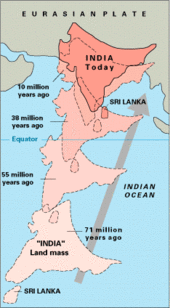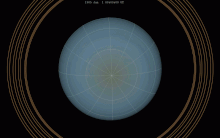User:ITK.MANIMARAN ER
ITK.MANIMARAN, Scientist | |
|---|---|
 EARTHQUAKE RESEARCHER | |
| Born | T.MANIMARAN 9 August 1989 |
| Nationality | Indian |
| Occupation | Scientist |
ITK.MANIMARAN EARTHQUAKE SCIENTIST. Born in Tamil Nadu's Cuddalore distict's Thennampakkam village,T.MANIMARAN was a genius in every way.On august 9th 1989 was born a man with extraordinary qualities.His father A.THANGAVEL was a member of family of electriction.His mother T.KALARANI came one sister her name is T.AmmuPhd one brother,his name is T.Sugumaran IT from a medel family.
Earthquake Research
[change | change source]
The ITK.MANIMARAN,Earthquake Scientist and Embedded, Designar.teh earthquake is before sensor. The Indian Plate or India Plate is a major tectonic plate straddling the equator in the eastern hemisphere. Originally a part of the ancient continent of Gondwana, India broke away from the other fragments of Gondwana 100 million years ago and began moving north.
Earth Plate movements
[change | change source]Three types of plate boundaries exist,[1] with a fourth, mixed type, characterized by the way the plates move relative to each other. They are associated with different types of surface phenomena. The different types of plate boundaries are:[2][3]



- Transform boundaries (Conservative) occur where two lithospheric plates slide, or perhaps more accurately, grind past each other along transform faults, where plates are neither created nor destroyed. The relative motion of the two plates is either sinistral (left side toward the observer) or dextral (right side toward the observer). Transform faults occur across a spreading center. Strong earthquakes can occur along a fault. The San Andreas Fault in California is an example of a transform boundary exhibiting dextral motion.
- Divergent boundaries (Constructive) occur where two plates slide apart from each other. At zones of ocean-to-ocean rifting, divergent boundaries form by seafloor spreading, allowing for the formation of new ocean basin. As the ocean plate splits, the ridge forms at the spreading center, the ocean basin expands, and finally, the plate area increases causing many small volcanoes and/or shallow earthquakes. At zones of continent-to-continent rifting, divergent boundaries may cause new ocean basin to form as the continent splits, spreads, the central rift collapses, and ocean fills the basin. Active zones of mid-ocean ridges (e.g., the Mid-Atlantic Ridge and East Pacific Rise), and continent-to-continent rifting (such as Africa's East African Rift and Valley and the Red Sea), are examples of divergent boundaries.
- Convergent boundaries (Destructive) (or active margins) occur where two plates slide toward each other to form either a subduction zone (one plate moving underneath the other) or a continental collision. At zones of ocean-to-continent subduction (e.g. the Andes mountain range in South America, and the Cascade Mountains in Western United States), the dense oceanic lithosphere plunges beneath the less dense continent. Earthquakes trace the path of the downward-moving plate as it descends into asthenosphere, a trench forms, and as the subducted plate is heated it releases volatiles, mostly water from hydrous minerals, into the surrounding mantle. The addition of water lowers the melting point of the mantle material above the subducting slab, causing it to melt.
How to earth Plate movements
[change | change source]
The Sun is composed primarily of the chemical elements hydrogen and helium. At this time in the Sun's life, they account for 74.9% and 23.8% of the mass of the Sun in the photosphere, respectively. The Sun's original chemical composition was inherited from the interstellar medium out of which it formed. Originally it would have contained about 71.1% hydrogen, 27.4% helium, and 1.5% heavier elements.

All celestial bodies in the Solar System, including planets such as our own, orbit around the Solar System's centre of mass. The sun makes up 99.76% of this mass which is why the centre of mass is extremely close to the sun.
Earth's orbit is the trajectory along which Earth travels around the Sun. The average distance between the Earth and the Sun is 149.60 million km (92.96 million mi),[4] and one complete orbit takes 365.256 days (1 sidereal year), during which time Earth has traveled 940 million km (584 million mi).[5] Earth's orbit has an eccentricity of 0.0167.
Axial tilt
[change | change source]
The Uranian axis of rotation is approximately parallel with the plane of the Solar System, with an axial tilt of 97.77° (as defined by prograde rotation). This gives it seasonal changes completely unlike those of the other planets. Near the solstice, one pole faces the Sun continuously and the other faces away. Only a narrow strip around the equator experiences a rapid day–night cycle, but with the Sun low over the horizon.At the other side of Uranus's orbit the orientation of the poles towards the Sun is reversed. Each pole gets around 42 years of continuous sunlight, followed by 42 years of darkness. ==

Template:Structure of the Sun.
The Sun and Earth axial tilt
[change | change source]the Earth's field in a period of normal polarity between reversals.[7] The lines represent magnetic field lines, blue when the field points towards the center and yellow when away. The rotation axis of the Earth is centered and vertical. The dense clusters of lines are within the Earth's core.[8]
Earth's magnetic field, also known as the geomagnetic field, is the magnetic field that extends from the Earth's interior out into space, where it meets the solar wind, a stream of charged particles emanating from the Sun. Its magnitude at the Earth's surface ranges from 25 to 65 microteslas (0.25 to 0.65 gauss).[9] Approximately, it is the field of a magnetic dipole currently tilted at an angle of about 11 degrees with respect to Earth's rotational axis, as if there were a bar magnet placed at that angle at the center of the Earth. The North geomagnetic pole, located near Greenland in the northern hemisphere, is actually the south pole of the Earth's magnetic field, and the South geomagnetic pole is the north pole. The magnetic field is generated by electric currents due to the motion of convection currents of molten iron in the Earth's outer core driven by heat escaping from the core, a natural process called a geodynamo.
While the North and South magnetic poles are usually located near the geographic poles, they can wander widely over geological time scales, but sufficiently slowly for ordinary compasses to remain useful for navigation. However, at irregular intervals averaging several hundred thousand years, the Earth's field reverses and the North and South Magnetic Poles relatively abruptly switch places. These reversals of the geomagnetic poles leave a record in rocks that are of value to paleomagnetists in calculating geomagnetic fields in the past. Such information in turn is helpful in studying the motions of continents and ocean floors in the process of plate tectonics.
The magnetosphere is the region above the ionosphere that is defined by the extent of the Earth's magnetic field in space. It extends several tens of thousands of kilometers into space, protecting the Earth from the charged particles of the solar wind and cosmic rays that would otherwise strip away the upper atmosphere, including the ozone layer that protects the Earth from harmful ultraviolet radiation.
Earth's magnetic field
[change | change source]Earth's magnetic field, also known as the geomagnetic field, is the magnetic field that extends from the Earth's interior out into space, where it meets the solar wind, a stream of charged particles emanating from the Sun. Its magnitude at the Earth's surface ranges from 25 to 65 microteslas (0.25 to 0.65 gauss).[9] Approximately, it is the field of a magnetic dipole currently tilted at an angle of about 11 degrees with respect to Earth's rotational axis, as if there were a bar magnet placed at that angle at the center of the Earth. The North geomagnetic pole, located near Greenland in the northern hemisphere, is actually the south pole of the Earth's magnetic field, and the South geomagnetic pole is the north pole. The magnetic field is generated by electric currents due to the motion of convection currents of molten iron in the Earth's outer core driven by heat escaping from the core, a natural process called a geodynamo.

.
- ↑ Meissner 2002, p. 100.
- ↑ "Plate Tectonics: Plate Boundaries". platetectonics.com. Archived from the original on 16 June 2010. Retrieved 12 June 2010.
- ↑ "Understanding plate motions". USGS. Retrieved 12 June 2010.
- ↑ "Sun: Facts & Figures". Solar System Exploration. National Aeronautics and Space Administration. Archived from the original on July 3, 2015. Retrieved July 29, 2015.
- ↑ Jean Meeus, Astronomical Algorithms 2nd ed, ISBN 0-943396-61-1 (Richmond, VA: Willmann-Bell, 1998) 238. See Ellipse#Circumference. The formula by Ramanujan is accurate enough.
- ↑ McComas, D. J.; Elliott, H. A.; Schwadron, N. A.; Gosling, J. T.; Skoug, R. M.; Goldstein, B. E. (2003-05-15). "The three-dimensional solar wind around solar maximum". Geophysical Research Letters. 30 (10): 1517. Bibcode:2003GeoRL..30.1517M. doi:10.1029/2003GL017136. ISSN 1944-8007.
- ↑ Cite error: The named reference
selfconsistentwas used but no text was provided for refs named (see the help page). - ↑ Glatzmaier, Gary. "The Geodynamo". University of California Santa Cruz. Retrieved 20 October 2013.
- ↑ 9.0 9.1 Finlay, C. C.; Maus, S.; Beggan, C. D.; Bondar, T. N.; Chambodut, A.; Chernova, T. A.; Chulliat, A.; Golovkov, V. P.; Hamilton, B.; Hamoudi, M.; Holme, R.; Hulot, G.; Kuang, W.; Langlais, B.; Lesur, V.; Lowes, F. J.; Lühr, H.; Macmillan, S.; Mandea, M.; McLean, S.; Manoj, C.; Menvielle, M.; Michaelis, I.; Olsen, N.; Rauberg, J.; Rother, M.; Sabaka, T. J.; Tangborn, A.; Tøffner-Clausen, L.; Thébault, E.; Thomson, A. W. P.; Wardinski, I.; Wei, Z.; Zvereva, T. I. (December 2010). "International Geomagnetic Reference Field: the eleventh generation". Geophysical Journal International. 183 (3): 1216–1230. Bibcode:2010GeoJI.183.1216F. doi:10.1111/j.1365-246X.2010.04804.x.
{{cite journal}}: Invalid|ref=harv(help)CS1 maint: unflagged free DOI (link) - ↑ "How does the Earth's core generate a magnetic field?". USGS FAQs. United States Geological Survey. Archived from the original on 18 January 2015. Retrieved 21 October 2013.
